牛津高中英语教案
- 格式:doc
- 大小:53.50 KB
- 文档页数:4
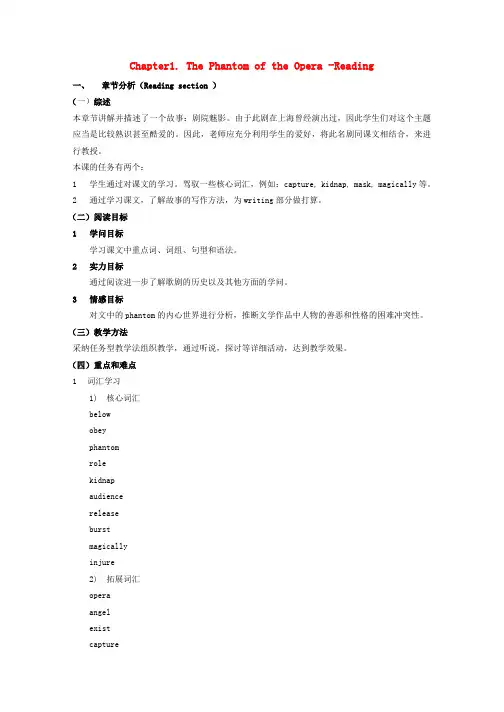
Chapter1. The Phantom of the Opera -Reading一、章节分析(Reading section )(一)综述本章节讲解并描述了一个故事:剧院魅影。
由于此剧在上海曾经演出过,因此学生们对这个主题应当是比较熟识甚至酷爱的。
因此,老师应充分利用学生的爱好,将此名剧同课文相结合,来进行教授。
本课的任务有两个:1学生通过对课文的学习。
驾驭一些核心词汇,例如:capture, kidnap, mask, magically等。
2通过学习课文,了解故事的写作方法,为writing部分做打算。
(二)阅读目标1学问目标学习课文中重点词、词组、句型和语法。
2实力目标通过阅读进一步了解歌剧的历史以及其他方面的学问。
3情感目标对文中的phantom的内心世界进行分析,推断文学作品中人物的善恶和性格的困难冲突性。
(三)教学方法采纳任务型教学法组织教学,通过听说,探讨等详细活动,达到教学效果。
(四)重点和难点1词汇学习1)核心词汇belowobeyphantomrolekidnapaudiencereleaseburstmagicallyinjure2)拓展词汇operaangelexistcapture3)词组和短语a huge building, with seventeen floorsforce him to leave homemake a secret home for sbgain power overmust bebe crowded within the endbe filling with waterbe shocked atmake sb do4)句型学习1. In the middle of this lake was an island, and on that island, one hundred yearsago, lived the Phantom2. …,he was so ugly that his own mother made him wear a mask,…教学设计(Teaching Designs)解。
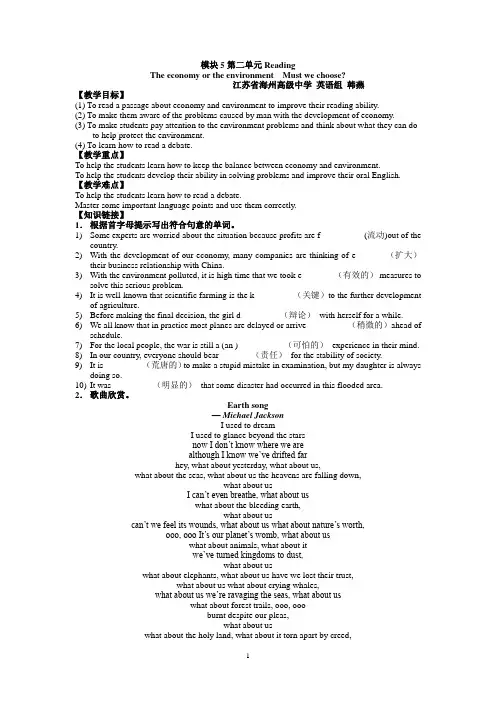
模块5第二单元ReadingThe economy or the environment Must we choose?江苏省海州高级中学英语组韩燕【教学目标】(1) To read a passage about economy and environment to improve their reading ability.(2) To make them aware of the problems caused by man with the development of economy.(3) To make students pay attention to the environment problems and think about what they can doto help protect the environment.(4) To learn how to read a debate.【教学重点】To help the students learn how to keep the balance between economy and environment.To help the students develop their ability in solving problems and improve their oral English.【教学难点】To help the students learn how to read a debate.Master some important language points and use them correctly.【知识链接】1.根据首字母提示写出符合句意的单词。
1)Some experts are worried about the situation because profits are f__________(流动)out of thecountry.2)With the development of our economy, many companies are thinking of e_______(扩大)their business relationship with China.3)With the environment polluted, it is high time that we took e________(有效的)measures tosolve this serious problem.4)It is well-known that scientific farming is the k________ (关键)to the further developmentof agriculture.5)Before making the final decision, the girl d_________(辩论)with herself for a while.6)We all know that in practice most planes are delayed or arrive ________ (稍微的)ahead ofschedule.7)For the local people, the war is still a (an ) _________ (可怕的)experience in their mind.8)In our country, everyone should bear ______ (责任)for the stability of society.9)It is ________ (荒唐的)to make a stupid mistake in examination, but my daughter is alwaysdoing so.10)It was ________ (明显的)that some disaster had occurred in this flooded area.2.歌曲欣赏。
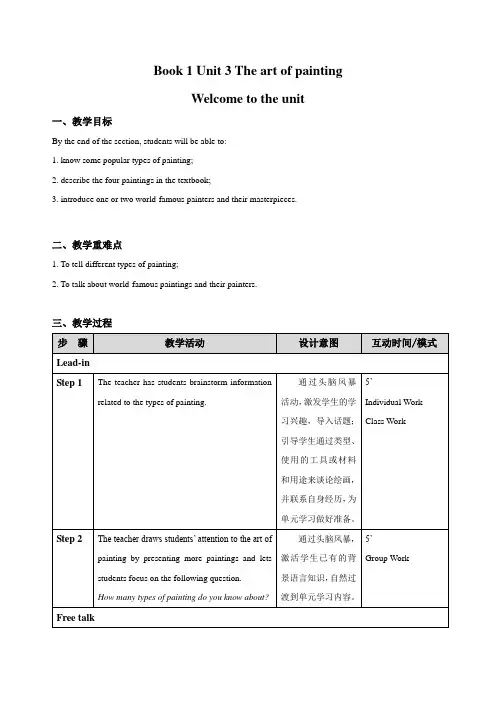
Book 1 Unit 3 The art of paintingWelcome to the unit一、教学目标By the end of the section, students will be able to:1. know some popular types of painting;2. describe the four paintings in the textbook;3. introduce one or two world-famous painters and their masterpieces.二、教学重难点1. To tell different types of painting;2. To talk about world-famous paintings and their painters.三、教学过程步骤教学活动设计意图互动时间/模式Lead-inStep 1 The teacher has students brainstorm information related to the types of painting.通过头脑风暴活动,激发学生的学习兴趣,导入话题;引导学生通过类型、使用的工具或材料和用途来谈论绘画,并联系自身经历,为单元学习做好准备。
5’Individual WorkClass WorkStep 2 The teacher draws students’ attention to the art of painting by presenting more paintings and letsstudents focus on the following question.How many types of painting do you know about?通过头脑风暴,激活学生已有的背景语言知识,自然过渡到单元学习内容。
5’Group WorkFree talk。
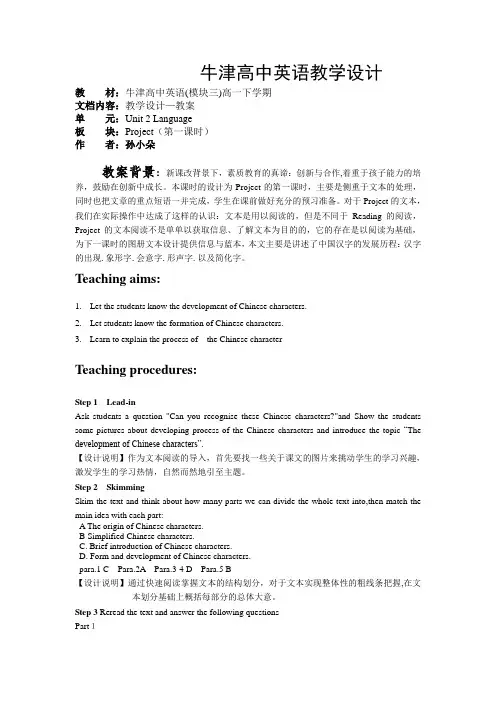
牛津高中英语教学设计教材:牛津高中英语(模块三)高一下学期文档内容:教学设计—教案单元:Unit 2 Language板块:Project(第一课时)作者:孙小朵教案背景:新课改背景下,素质教育的真谛:创新与合作,着重于孩子能力的培养,鼓励在创新中成长。
本课时的设计为Project的第一课时,主要是侧重于文本的处理,同时也把文章的重点短语一并完成,学生在课前做好充分的预习准备。
对于Project的文本,我们在实际操作中达成了这样的认识:文本是用以阅读的,但是不同于Reading的阅读,Project的文本阅读不是单单以获取信息、了解文本为目的的,它的存在是以阅读为基础,为下一课时的图册文本设计提供信息与蓝本,本文主要是讲述了中国汉字的发展历程:汉字的出现.象形字.会意字.形声字.以及简化字。
Teaching aims:1.Let the students know the development of Chinese characters.2.Let students know the formation of Chinese characters.3.Learn to explain the process of the Chinese characterTeaching procedures:Step 1 Lead-inAsk students a question "Can you recognise these Chinese characters?"and Show the students some pictures about developing process of the Chinese characters and introduce the topic “The development of Chinese characters”.【设计说明】作为文本阅读的导入,首先要找一些关于课文的图片来挑动学生的学习兴趣,激发学生的学习热情,自然而然地引至主题。
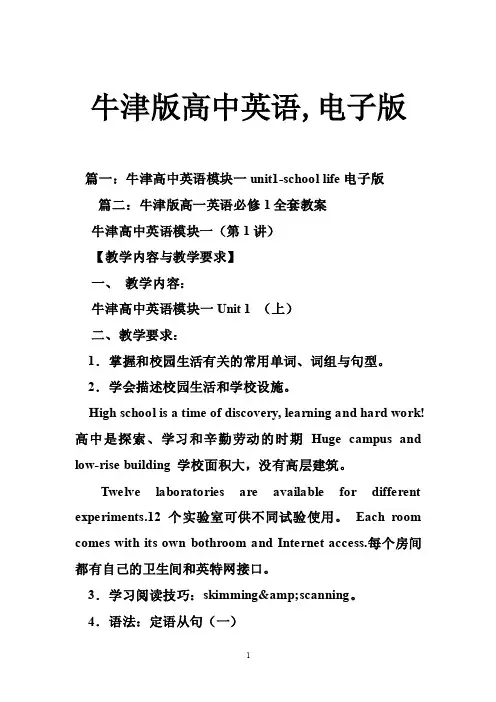
牛津版高中英语,电子版篇一:牛津高中英语模块一unit1-school life电子版篇二:牛津版高一英语必修1全套教案牛津高中英语模块一(第1讲)【教学内容与教学要求】一、教学内容:牛津高中英语模块一Unit 1 (上)二、教学要求:1.掌握和校园生活有关的常用单词、词组与句型。
2.学会描述校园生活和学校设施。
High school is a time of discovery, learning and hard work!高中是探索、学习和辛勤劳动的时期Huge campus and low-rise building 学校面积大,没有高层建筑。
Twelve laboratories are available for different experiments.12个实验室可供不同试验使用。
Each room comes with its own bothroom and Internet access.每个房间都有自己的卫生间和英特网接口。
3.学习阅读技巧:skimming&scanning。
4.语法:定语从句(一)【知识重点与学习难点】一、重要单词:access achieve attend assembly article available averagecanteen club challenging context donate display experience extra graduate gym heading locker low-rise literature poster relax二、重点词组:class teacher 班主任at ease with 和….相处不拘束school hours学校作息时间earn respect from 赢得…的尊敬sound like听起来象for free 免费get a general idea 了解大意as well as 除….以外, 也key words 关键词word by word 逐字逐句地find one’s way around 认识路develop an interest in 培养对….的兴趣surf the Internet网上冲浪【难点讲解】1. What is your dream school life like?你理想中的学校生活是什么样子?这里dream 表示心目中最理想的. 如dream team (梦之队)。
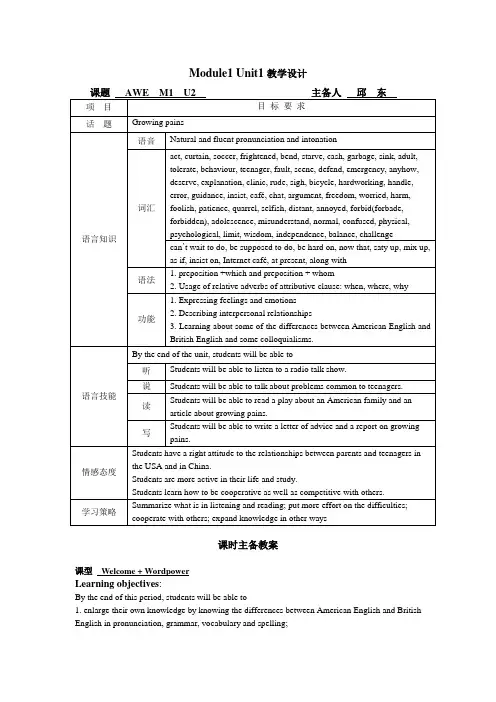
Module1 Unit1教学设计课时主备教案课型Welcome + WordpowerLearning objectives:By the end of this period, students will be able to1. enlarge their own knowledge by knowing the differences between American English and British English in pronunciation, grammar, vocabulary and spelling;2. improve their spoken skills by describing their own experiences or speaking about what they have heard or seen in the past tense;3. be aware of the sense of language by learning some English colloquialisms.Focus of the lesson:1. relations between parents and teenagers2. differences between American English and British English3. different colloquialismsPredicted area of difficulties:1. how to improve the relationships between parents and teenagers if they are not so good;2. how to use colloquialisms properly.Learning aids:1. PPT2. blackboard课型Reading(I)Learning objectives:By the end of this period, students will be able to1. know more information about American family life;2. learn the basic skills of how to read a play and act out the play with the help of a teacher;3. form a positive attitude towards growing pains.Focus of the lesson:1. characteristics of a play;2. a performance of a play;Predicted area of difficulties:How to act in the play?Learning methods:1. PPT2. blackboard课型Reading(II)Learning objectives:By the end of this period, students will be able to1. write out the transformation of the key words and phrases correctly;2. use the key words properly in relevant tasks;3. know some words and phrases in a play;4. raise the awareness of learning new words or phrases in a context.Focus of the lesson:1. usage of the key words and expressions;2. verb tenses in a play and some stage instructions.Predicted area of difficulties:1. the usage of the following words and phrases …follow‟ …be supposed to do‟ …tolerate …deserve‟and so on;2. the proper usage of relative adverbs.Learning aids:1. PPT2. blackboardLearning procedures:课型Grammar & UsageLearning objectives:By the end of this period, students will be able to1. better understand the grammatical functions of attributive clauses;2. use prepositions +which / whom3. use relative adverb s …when‟ …wh ere‟ …wh y‟ ;4. enjoy the neatness & beauty of attributive clauses comparing them with simple sentences. Focus of the lesson:1. the usage of relative adverbs;2. the exchange of “prepositions +which” and relative adverbs.Predicted area of difficulties:1. the usage of relative adverbs;2. how to distinguish relative pronouns and relative adverbs.Learning aids:1. PPT2. blackboardLearning procedures:课型TaskLearning objectives:At the end of this lesson, students will be able to:1. understand the main points and the mood of the writer by reading four diary entries.2. know how to write a letter for advice and a letter of reply.3. know a better way to solve the problem between teenagers and parents.Focus of the lesson:Reading for key points and main idea.Predicted learning difficulties:How to get the key points in a diaryLearning aids:1. PPT2. blackboardLearning procedures:课型ProjectLearning objectives:By the end of this period, students will be able to:1. know what are growing pains;2. identify the three types of changes of growing pains;3. learn to deal with the changes properly and develop healthily both physically and mentally.Focus of the lesson:1. three kinds of changes;2. proper ways to deal with them;Learning aids:1. PPT2. blackboardLearning procedures:。
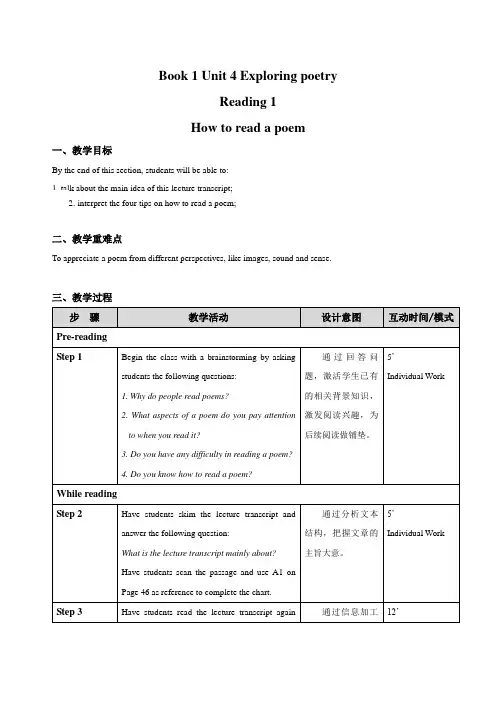
Book 1 Unit 4 Exploring poetryReading 1How to read a poem一、教学目标By the end of this section, students will be able to:1. talk about the main idea of this lecture transcript;2. interpret the four tips on how to read a poem;二、教学重难点To appreciate a poem from different perspectives, like images, sound and sense.三、教学过程步骤教学活动设计意图互动时间/模式Pre-readingStep 1 Begin the class with a brainstorming by askingstudents the following questions:1. Why do people read poems?2. What aspects of a poem do you pay attentionto when you read it?3. Do you have any difficulty in reading a poem?4. Do you know how to read a poem?通过回答问题,激活学生已有的相关背景知识,激发阅读兴趣,为后续阅读做铺垫。
5’Individual WorkWhile readingStep 2 Have students skim the lecture transcript andanswer the following question:What is the lecture transcript mainly about?Have students scan the passage and use A1 onPage 46 as reference to complete the chart.通过分析文本结构,把握文章的主旨大意。

《英语》(选择性必修·第一册)Unit 1 Food mattersIntegrated skills (II)I. Learning objectivesBy the end of the lesson, students will be able to:1. talk about their favorite food, including its appearance, smell, taste, ways of cooking and a particular experience associated with it;2. write an article about their favorite food.II. Key competence focusWrite an article about their favorite food.III. Predicted area of difficulty1. How to convey the ideas clearly.2. How to write an article vividly.IV. Teaching proceduresStep 1 Lead-in1.T presents some pictures of food such as mooncake, Tiramisu, dumpling, hot pot, etc. and asks the following questions:Picture 1 (Mooncake)T: What can you see in the picture?S: Mooncakes.T: Have you tried a mooncake?S: Yes.T: When did you try it for the first time?S: I gave it my first try at the age of 5.T: Do you like it?S: Yes, very much.T: How does it taste?S: It tastes sweet.Picture 2 (Tiramisu)T: Do you know the dessert in the picture?S: It is Tiramisu.T: How does it look?S: It looks adorable.Picture 3 (Dumpling)T: What’s the picture about?S: Dumplings.T: Do you know how to cook the dish?S: It can be steamed, boiled or fried.Picture 4 (Hot pot)T: What’s it?S: It’s a hot pot.T: How do you think it feels in your mouth?S: I think it is spicy.2. T asks more questions as follows:T: What’s your favorite food? Why do you like it?(Ss may give various answers.)3. T shows a picture of salted duck and mentions her experience of tasting it for the first time.T: Salted duck is one of my personal favorites. I gave it my first try twenty years ago, together with my family members. My father went on a business trip to Nanjing and brought one back. Itlooked mouth-watering. Before my mother sliced it, brother and I couldn’t wait to have a try. The meat was juicy and salty, which really impressed all of us. How can I forget such a tasty dish?【设计意图:通过互动,引入主题,并为对话环节做铺垫。
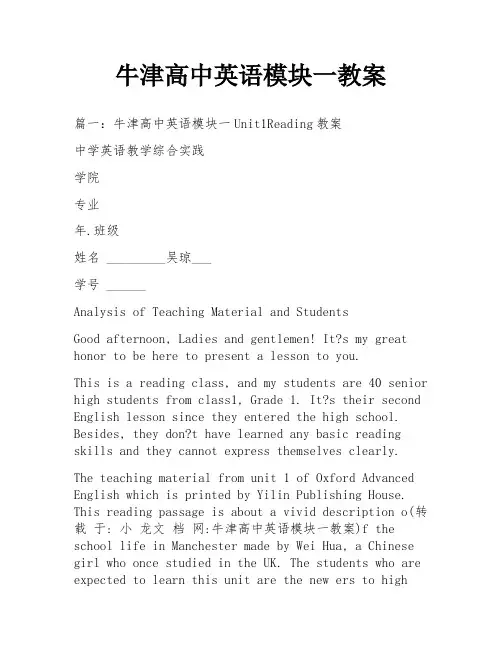
牛津高中英语模块一教案篇一:牛津高中英语模块一Unit1Reading教案中学英语教学综合实践学院专业年.班级姓名 _________吴琼___学号 ______Analysis of Teaching Material and StudentsGood afternoon, Ladies and gentlemen! It?s my great honor to be here to present a lesson to you.This is a reading class, and my students are 40 senior high students from class1, Grade 1. It?s their second English lesson since they entered the high school. Besides, they don?t have learned any basic reading skills and they cannot express themselves clearly.The teaching material from unit 1 of Oxford Advanced English which is printed by Yilin Publishing House. This reading passage is about a vivid description o(转载于: 小龙文档网:牛津高中英语模块一教案)f the school life in Manchester made by Wei Hua, a Chinese girl who once studied in the UK. The students who are expected to learn this unit are the new ers to highschools. They will certainly curious about British high school life as well as their own school life. So the topic is an amazing one for the students, and it will definitely stimulate the students? interest since they can imagine and arrange their own new school life.Before this lesson, I?ll1.Ask the students to prepare for a free-talk for about two or three minutes. They can introduce themselves to their classmates or say something about their junior middle school life, or even make a plan for their high school life. This will help all the students to take part in in-class activities and help them adapt to high school life quickly. If some students really have some difficulty in doing this, the teacher can help them to prepare for it before class.2. Encourage the students to go to the library or surf the Internet to get some information about school life in the UK, if possible. They can also be divided into several groups to get some information about high school life in different countries as they like.3. Ask the students to read the passage School life in the UK on pages 2 to 3, as well as reading strategy on page 3. If time permits, ask them to finish exercises C1, C2 and D on page4.While the students are reading this passage, some reading strategies should be introduced: skimming—to get the general idea of a passage by looking at thetitles and headings, the first and last sentences of paragraphs and the first and last paragraphs as well as pictures and chart; scanning—to find certain information in a text quickly by looking for key words and phrases, dates, numbers, etc.Task-based Language Teaching methods, Communicative Language Teaching methods and Situational Language Teaching methods will be used in my class. Meanwhile, different in-class activities should be well organized for all the students to take part in according to the content of the text with the purpose of training their skills in not only reading, but also in listening and speaking. Some charts and tables are used for the students to find some information for the text. And the students should be encouraged to take part in different activities of pair work or group work. They should learn to enjoy team-work. More in-class activities are related to the students? daily life and require mon sense from the students. And more exercises are given in different forms to help the students to learn how to use some of the new words and phrases.By the end of the class, for the instructional objectives, first, students are able to master the vocabularies and phrases: attend, earn, respect, achieve, challenging, prepare, drop, miss, experience, introduce, for free, at lunchtime, word by word, on average, sound like. Also , the sentence structures: 1)This means I could. . . 2)I found the homework was not as heavy as what Iused to get. . .For the educational objectives, firstly, enable the students to learn to talk about school life and identify the differences in the school life between the UK and China. Secondly, help the students to learn to make an outline of a plan for their new school life.For the personal objectives, the teacher is able to know how to manage a class more effectively and arouse students? interests in a reading class.My teaching procedures are divided into 4 stages: warm-up, pre-reading, while-reading and post-reading. They all will be represented later, so here es my class.School life in the UK吴琼ⅠBackground informationStudents: 40 senior high school students, Grade 1Teaching materials: School life in the UKEducation system in the UKType of the lesson: ReadingTeaching methods:Task-based Language TeachingCommunicative Language TeachingSituational Language TeachingLesson duration: 40minsDate: November 17, 2015Teaching aids: blackboard, chalk, PPT, textbookⅡLanguage ContentsVocabulary:Words for production: attend, earn, respect, achieve, challenging, prepare, drop, miss, experience, introduce,Words for recognition: attend, earn, respect, achieve, challenging, prepare, drop, miss, experience, introduce,Phrases:for free, at lunchtime, word by word, on average, sound like.Sentence structures: 1)This means I could. . .2)I found the homework was not as heavy as what I used to get. . . ⅢFocal & Difficult pointsa. Focal point:Develop the two reading skills: skimming and scanning.b. Difficult point:1. Help the students to learn about the school life in the UK and get the students to talk about the differences in the school life between the UK and China.2. Help the students to learn to use some of the new words and expressions.3. Help the students to learn to make an outline of a plan for their new school life.ⅣTeaching ObjectivesBy the end of the class, students are able to:a. Instructional objectives:1. Learn some useful words and expressionsattend, earn, respect, achieve, challenging, prepare, drop, miss, experience, introduce, for free, at lunchtime, word by word, on average, sound like.2. Learn some important sentence structures1)This means I could. . .2)I found the homework was not as heavy as what I used to get. . .3.Train the students? reading ability, introducing the two ?reading strategies?, skimming and scanning.b. Educational objectives:1.Enable the students to learn to talk about school life and identify the differences in the school life between the UK and China.2.Help the students to learn to make an outline of a plan for their new school life.c. Personal objective:The teacher is able to:1. Know how to manage a class more effectively.2. Arouse students? interests in a reading class.ⅤTeaching ProcedureStage 1 warn up (7 mins)→Step 1 Greetings and self-introductionT:This is the first semester of the high school and most of you are not familiar with each other, so self-introduction is necessary for you to get to know about each other. Please be a volunteer to go to the front of the classroom and make a self-introduction or describe part of your junior middle school life and make a plan for their high school life.S:My name is...T:Well done. After Mary finishes her free-talk, the rest of you can ask her some questions. S:Mary, I want to ask you a question...→Step 2 Lead inT:We have learnt Wele to the Unit last lesson, please describe some parts of high school life in the UK based on what you have learned in that section.T:Anybody wants to raise up his hand? Well, Bonne please.S:Huge campus and low-rise buildings can often be seen in the UK. That is an outstanding sight when we travel in the UK, pared to so many high-rise buildings in China. Balabala...T:Thank you, Bonne. Good job.T: The British school system is considered one of the best in the world. As is known to us all, education in the UK is pulsory for everyone between the ages offive and sixteen, and is provided by two kinds of schools: independent (fee-charging) schools and state-funded schools.T:Please pay attention to the contents on the bottom of page1. There are several pictures of the schoollife in the UK. I need you to describe some of the scenes in the pictures about the school life in the UK.T: Any volunteer? OK, Victoria please.S:They are so many in-class activities in the their class. I think we should have more opportunities to work in pairs or in groups.T:Good girl, sit down please. You guys have done good job. There is more I want to talk about. It seems that their classes are loose, but in fact well organized. Do you agree with me?S:Yes!Stage 2 Pre-reading (8 mins)→Step 3 ReadingTask1 SkimmingIn order to help the students to know how to skim a passage, the teacher get the following篇二:牛津高中英语模块一全册教案牛津高中英语模块一(第1讲)【教学内容与教学要求】一、教学内容:牛津高中英语模块一Unit 1 (上)二、教学要求:1.掌握和校园生活有关的常用单词、词组与句型。
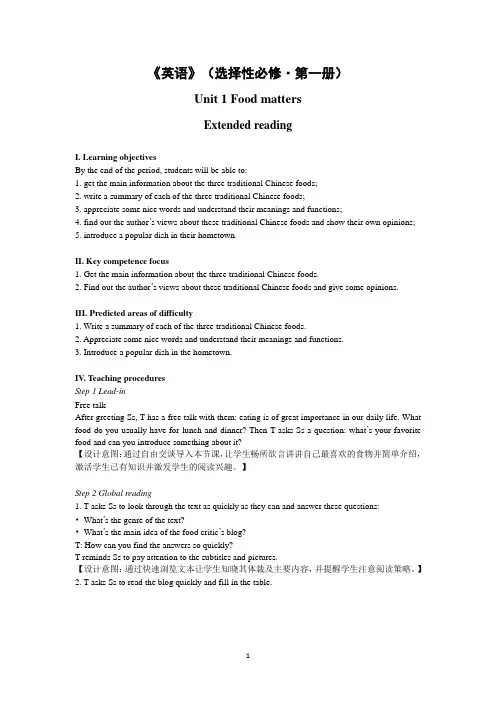
《英语》(选择性必修·第一册)Unit 1 Food mattersExtended readingI. Learning objectivesBy the end of the period, students will be able to:1. get the main information about the three traditional Chinese foods;2. write a summary of each of the three traditional Chinese foods;3. appreciate some nice words and understand their meanings and functions;4. find out the author’s views about these traditional Chinese foods and show their own opinions;5. introduce a popular dish in their hometown.II. Key competence focus1. Get the main information about the three traditional Chinese foods.2. Find out the author’s views about these traditional Chinese foods and give some opinions.III. Predicted areas of difficulty1. Write a summary of each of the three traditional Chinese foods.2. Appreciate some nice words and understand their meanings and functions.3. Introduce a popular dish in the hometown.IV. Teaching proceduresStep 1 Lead-inFree talkAfter greeting Ss, T has a free talk with them: eating is of great importance in our daily life. What food do you usually have for lunch and dinner? Then T asks Ss a question: what’s your favorite food and can you introduce something about it?【设计意图:通过自由交谈导入本节课,让学生畅所欲言讲讲自己最喜欢的食物并简单介绍,激活学生已有知识并激发学生的阅读兴趣。
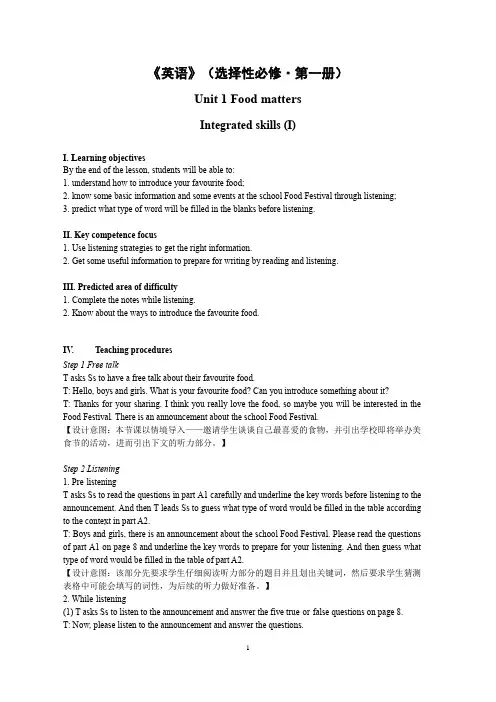
《英语》(选择性必修·第一册)Unit 1 Food mattersIntegrated skills (I)I. L earning objectivesBy the end of the lesson, students will be able to:1. understand how to introduce your favourite food;2. know some basic information and some events at the school Food Festival through listening;3. predict what type of word will be filled in the blanks before listening.II. Key competence focus1. Use listening strategies to get the right information.2. Get some useful information to prepare for writing by reading and listening.III. Predicted area of difficulty1. Complete the notes while listening.2. Know about the ways to introduce the favourite food.IV. Teaching proceduresStep 1 Free talkT asks Ss to have a free talk about their favourite food.T: Hello, boys and girls. What is your favourite food? Can you introduce something about it?T: Thanks for your sharing. I think you really love the food, so maybe you will be interested in the Food Festival. There is an announcement about the school Food Festival.【设计意图:本节课以情境导入——邀请学生谈谈自己最喜爱的食物,并引出学校即将举办美食节的活动,进而引出下文的听力部分。
Book 1 Unit 3 The art of paintingIntegrated skills 1Giving instructions for making an unusual picture一、教学目标By the end of this section, students will be able to:1. identify examples with the help of related expressions;2. speak about what image they will create, what materials and tools they will use for the picture and what steps it will take to create the picture;3. write instructions on creating an unusual picture step-by-step.二、教学重难点1. To practice one’s listening, reading and speaking skills in contexts;2. To form independent opinions about making an unusual picture.三、教学过程步骤教学活动设计意图互动时间/模式Lead-inStep 1 The teacher has students answer the following questions.1. Do you know how many different types of paintingsand famous painters there are in the world?2. Which type of paintings are you interested in? Why?激发学生学习更多绘画相关的词汇和知识的热情,激活学生已有的背景知识,再次回顾单元主题,为本课学习做好热身准备。
Unit 2The universal languageGrammar and usageI. Learning objectivesBy the end of the lesson, students will be able to:1. identify the use of verb-ing forms as subjects and objects;2. use verb-ing forms as subjects and objects in different situations;3. write a passage using verb-ing forms correctly.II. Key competence focus1. Identify the use of verb-ing forms as subjects and objects.2. Use verb-ing forms as subjects and objects in different situations.III. Predicted area of difficulty1. Use verb-ing forms as subjects and objects in different situations.2. Write a passage using verb-ing forms correctly.IV.Teaching proceduresStep 1 Lead-inT shows Ss some sentences with verb-ing forms as subjects and objects in the previous units and asks them to figure out the functions of these verb-ing forms.T: Hello, everyone. First, I’d like to show you some sentences with verb-ing forms in the previous units. Go through these sentences and figure out the functions of these verb-ing forms.·Sliding into the habit was easy, but it was difficult to quit the habit. (B3 U3)(verb-ing forms as subject)·We’ll come back more frequently and we’re also consideringtaking them to the city to live with us. (B2 U3)·As the largest rainforest in the world, the Amazon rainforest plays a significantrole in maintaining the fine balance of the Earth’s ecosystem. (B3 U1)·I was used to checking the news and my friends’ social media updates every few minutes. (B3 U3)(verb-ing forms as objects)T: In the first sentence, “sliding into the habit” serves as a subject. In the next three sentences, the underlined parts function as objects.【设计意图:学生在之前的课文中,已经接触了一些verb-ing形式用作主语和宾语的句子。
牛津版的高中英语教案设计5篇牛津版的高中英语教案设计1(一) 明确目标1. Get the students to know the importance of body language.2. Train the students integrating skills.(二)整体感知Step 1Show more gestures and let the students guess the meanings. Step 2Read the integrating skills.(三) 教学过程Step 3Introduce Shuang huang.Step 4Work in pairs and make up a funny story.Step 5Practice Writing.(四)总结扩展Step 6Compare the meanings of body language in China and the USA. Meaning in China Body language Meaning in the USAwelcome a smile and a handshake welcomeHello Goodbye ! waving one s hand Hello! Hi! Goodbye!disagreement shaking the head disagreementagreement nodding the head agreementMay I ask a question putting up a hand May I ask a question.love kissing loveno such a gesture keeping ones fingers crassed hoping sth. goodwill happenproud holding up ones head not afraid/proudfeeling sorry for having done hanging ones head feeling sorry for having donefeeling very happy waving ones arm feeling very happydislike, disagreement or pain making a face dislike, disagreementor painIm full/ I v eat stomachache touching ones stomach having a stomachache(五)随堂练习1. Choose the best answers according to the situations.When you meet a foreign guest for the first time, you should say: A. How do you do B. How are youC. Hi!D. Hello! What can I do for you2. Yon are carrying some heavy boxes. Someone comes over to offer help. He may say Can I help you If you need his help, you should say: A. Of course, you can. B. Thats a good idea.C. Yes, go ahead.D. Thanks. Thats very kind of you.3. If you can carry the boxes yourself and don’t need his help,you should say to him:A. No. I don’t need your help.B. Its none of your business.C. No, thanks. I can manage it myself.D. Sorry, you can’t4. When you see an old lady carrying a heavy bag and want to goover to help her, you should say:A. Excuse me, madam. Would you like me to crazy it for youB. Hello! Let me carry the bag for you. It’s too heavy for an oldlady like you.C. Hi, Granny! Let me carry the heavy bag for you. You are old.D. Excuse me. Is there anything else I can do for you2. Choose the right words for the blanks, using the right verb forms.proud juice dining room realize were type comfortable.(1) I hope you feel as __ as you are at home.(2)The speaker ____ to the people in the hall before he left.(3)You’d better make the apples into ____ for your baby; otherwise she can’t eat them.(4) Before you send your article to the publisher, you’dbetter____ it out with a computer or a type-writer.(5)The students neednt go home for lunch, because there is a _____ in the school.(6)I didnt _____ they were a couple (夫妻) until the party was over.(7) She looked so __ at the party that few people talked to her.3. Make gestures and guess what they mean.(1) Raise your hand. (5) Kiss your hand to someone.(2)Put up your hands. (6)Thumbs (大拇指) up.(3)Wave your hand. (7)Thumbs down.(4) Cup your ear. (8) Bite your nails ( 指甲 ).参考答案:1. (1)A (2)D (3)C (4)A2. (1)comfortable (2)waved (3)juice (4)type (5)dining-room(60realize (7)proud3.(1) To ask or answer a question. / To attract attention. / To sayhello.(2)To give up. / To surrender.(3)To say goodbye.(4)To say: I beg your pardon. / Sorry, I can’t hear you.(5)To say Goodbye to a dear friend or relative.(6)To say Great! / Wonderful! / Well done! / Congratulations !(7)To say No good! / Terrible!(8)To mean thinking or “worrying”.牛津版的高中英语教案设计2教学准备教学目标■To help students learn to express attitudes, agreement disagreement and certainty■To help students learn to read the text and learn to writediaries in English■To help students better understand “friendship”■To help students learn to understand and use some important words and expressions■To help students identify examples of Direct Speech Indirect Speech (I): statements and questions in the text教学重难点Wordsupset, ignore, calm, concern, settle, suffer, recover, packExpressionsadd up, calm down, have got to, be concerned about, go through, set down, a series of, on purpose, in order to, at dusk, face to facer, no longer/ not …any longer, suffer from, get/ be tired of, pack (sth.) up, get along with, fall in love, join inPatterns“I don’t want to set down a series of facts in a diary as most people do,” said Anne. →Anne said that she didn’t want to set down a series of facts in a diary as most people do.I stayed awake on purpose until half past eleven……it was the first time in a year and a half that I’d seen the night face to face…教学工具ppt教学过程Hello, everyone. I’m so glad to be your teacher of English. I’d like to make friends with you, to build up a close friendship with you. Today we shall take Unit 1. The topic of this unit is Friendship. What do you think friendship is1. Warming up⑴ Warmi ng up by defining friendshipHello, everyone. I’m so glad to be your teacher of English. I’d like to make friends with you, to build up a close friendship with you. Today we shall take Unit 1. The topic of this unit is Friendship. What do you think friendship isYeah, there are many explanations about friendship. However, friendship is a relationship that can’t be restricted(限制)by definition(定义). It can only be experienced. True friendship can exist between any two souls, be it between people or animals. It can happen at any moment, to anyone. Even to lifeless things, like a diary, a ball, a friendship can happen.Then what is your opinion about friendshipDo you think that friendship is important to our life Why⑵Warming up by learning to sol ve problemsNice to meet you, class. We shall be friends from now on. For everybody needs friends. But being a good friend can sometimes be hard work. Learning how to solve problems in a friendship can make you a better friend and a happier person. Discuss the situation below and try to solve the problems wisely.Common problems among teenagersSolutionSome of the common problems include forgetting friends’ birthday, not keeping promises, letting out friends’ secrets and so on.Maybe we can have a heart-to-heart talk with our friends to ask for forgiveness.Situation 1: Friends get angry with each other when they try totalk about something difficult.Try to understand your friend/ Try to talk about the problem in a different way.Si tuation 2: Friends don’t know how to apologizeStart by telling each other that you are sorry. A simple apology is often enough and is a good starting point.Situation 3: Some friends don’t know how to keep secrets.Keep your secrets to yourselfTips on being a good friendTreat your friends the way you want to be treated. Keep secretsthat are told to you.Pay attention when your friend is talking. Keep your promises. Share things with your friend. Tell your friend the truth. Stick up for your friend.⑶Warming up by doing a surveyGood morning, class. I am your teacher of English. Glad to be here with you. Today we shall take Unit 1 Friendship.To be frankly, I’d like very much to keep a close friendship with you, my dear students, in the following years. How about you then Ok, thanks. I do hope to be your good teacher as well as your helpful friend (良师益友).Now please do the survey on page one.Add up your score according to the scoring sheet on page 8. You don’t have to tell your results. You can just keep it a secret.牛津版的高中英语教案设计3教学准备教学目标Teaching Objectives1. Students are able to learn more about nonverbal humour as well as Charlie Chaplin through network-based.2. Students are able to get the gen eral idea and detailed information of the passage by skimming, scanning as well asinterpreta tion and appreciation.3. Students will learn to face difficulties in life with optimism and humour as well as learn to cooperate with others in groups.教学重难点Teaching difficult points1. How to guide students to search for and sort out related information according to the assigned task through the Internet.2. How to cu ltivate students’ learning ability through teamwork based on network.Teaching important points1. Help students to get the general idea and detailed informationof the text effectively by skimming and scanning.2. Help students to analyze the reasons for Charlie Chaplin’s success by interpreting the key sentences and get them inspired.教学过程Step 1Lead-in(3 mins)1.Students’ Activities:2.The Purpose of ActivitiesStudents are to appreciate a video clip performed by Mr. Bean.Students will be guided to acquire the form of nonverbal humour in a vivid way,thus eage r to learn about the main character of the text with interest.Step 2Network-based Interactive Learning(25 mins)1.Students’ Activities(1).Students are divided into five groups to search for and sorted out the related information according to the assigned task online(2)A representative of each group is to share the information with the others.2.the Purpose of ActivitiesStudents will develop their ability to effectively sort out information on the Internet throug h group cooperation as well asfeel a sense of achievement by their oral presentation.Step3 Text-based Reading(17 mins)Students’ Activities 1. Students are to read the text quickly, and then answer the questions according to the text. 2. Read Paragraph 3 carefully, and then answer the question ---Why did “the littletramp”become Charlie Chaplin’ famous character 3. Read Paragraph 4 and fill in the blanks.4. Find out the sentences that can account for Charlie Chaplin’s success from the text.2.The Purpose of Activities(1)Students will get the general idea as well as the structu re of the text by skimming.(2)Students will get the detailed information and have a deeper understanding of the text.(3) Students will get inspired while analyzing the secret to Charlie Chaplin’s success by interpre ting and appreciating some key sentences in the text.课后习题Step 5 Homework1. Students are to read the text carefully again and underline the phrases and sentences difficult to understand after class.2. Write a summary (about 130 words).牛津版的高中英语教案设计4教学准备教学目标(1)知识目标:让学生通过阅读课文更多地了解我国的农业科学家袁隆平的科研成果及其影响。
Book 1 Unit 2 The universal languageReading 1Understanding culture through music一、教学目标By the end of this section, students will be able to:1. give a brief introduction to Butterfly Lovers and country music;2. listen to a sample of Butterfly Lovers and express their understanding of it;3. compare the writing techniques of the two emails.二、教学重难点1. To appreciate different types of music and understand the culture through music;2. To learn about different techniques used in writing to describe one’s appreciation of music.三、教学过程步骤教学活动设计意图互动时间/模式Pre-readingStep 1 Start the class by asking students to answer the following questions.1. What information do you think the emailscontain according to the subjects?2. Have you watched a music performance live oron TV? What was it like?激活学生已有的关于音乐表演的认知和经验,引出主题,引导学生关注电子邮件的写作特征。
Book 1 Unit 3 The art of paintingReading 2First impressions一、教学目标By the end of this section, students will be able to:1. summarise the main idea of the travel journal;2. apply different expressions to describing the similarities or the differences between two things.二、教学重难点1. To retell the journal through clarifying the context of the passage;2. To learn to use sentences showing comparison.三、教学过程步骤教学活动设计意图互动时间/模式RevisionStep 1The teacher has the students review the text and read the last paragraph of the travel journal and answerthe following questions.1. What are the similarities of the Impressionists’paintings?2. What do you know about Vincent van Gogh?The teacher has the students finish B1 on Page 33 topractise the use of new words and expressions.复习课文内容,为“阅读策略”环节做好铺垫。
8’Class WorkReading strategyStep 2 Students learn about comparison words and phrases.1. Read the instructions in B3 and know words andexpressions that can be used to makecomparisons.通过学习课文中“比较”词汇的用法,帮助学生掌握“比较”的表5’Individual Work。
Lesson Plan on The Honourable Games学科教学英语谢咪2013020430背景介绍:高一学生已经有了一定的语言基础,同时有相对较高的学习主动性,所以教学重点在于知识获取和综合运用语言能力的提高。
而阅读作为教学载体可以提供给学生文化知识,文体知识,以及在消化这些内容过程中所需要的自学与合作学习的机会,并从中得到精神的提升,因此设计知识,技能,情感三维一体的教学时值得考虑的;同时,高中英语一般是以两节课为一个课时单位,所以,课堂活动应考虑融入听说读写多种活动尽量丰富,克服学生疲惫。
教学内容:The Honourable Games 是译林牛津版模块4 Unit 2 Sporting Events的课文(22-23)。
本课主要以演讲的形式向大家介绍了奥运会的历史、意义以及国内外的一些著名运动员。
同时课后配有练习题来检验和巩固学生对课文理解以及重点词汇掌握(24-25)。
教学目标:通过学习学生能够1.掌握新单词significance 等等。
1.谈论奥运会的历史,意义以及介绍自己喜欢的运动员。
2.抓住阅读一篇演讲稿的要领以及提高自己聆听演讲的能力。
3.增强自主学习意识以及课堂合作意识。
4.体会到奥运会的意义以及培养爱国精神。
教学重难点:重点:理解课文内容。
难点:联系上下文理解单词意思。
教学步骤:The first 45 minutesI Pre-readingStep1 ( 3 m )Greeting and showing pictures to students.T: Who is he? S: Tian Liang.T: What does he do now? S: A TV star.T: How much do you know about him? S:……设计意图:从学生比较熟悉的奥运运动员入手,引出本课主题。
Step 2 ( 7 m )While students answering the questions, a chart will be provided to invite other students to finish it.Name Nationality WhichOlympics OlympicachievementsOtherinformationTian Liang ChinaT:Please look at the table and listen to your classmates carefully, later you will be asked to fill in it. S: ……T:It seems that you know him well, but do you know some other athletes home and in other countries? Now, please turn to page 23, and read paragraph 6.设计意图:以表格引导学生进行知识梳理,并为学生阅读课文寻找其他运动员信息做铺垫。
同时增强学生课堂注意力与合作意识,可能说的同学的语速更缓慢语调更清晰些,更认真考虑回答内容,其他同学会更仔细地听,也是互相尊重。
II While-readingStep 3Scanning ( 15 m )Name Nationality WhichOlympics OlympicachievementsOtherinformationTian Liang ChinaThe above chart will be pointed to students to help them organize the information they’ve read. Grouping students in pairs to check their work.设计意图:在学生注意力集中的时候是他们进行知识分类整理可以减轻学生在阅读时的压力。
Step 4Skimming ( 10 m )T: you can see all of them perform great in a common sports meeting, what?S: The Olympic games. (如果学生没反应,则自己作答,点出题目)T: Now please listen to the tape, let’s get more information about the honourable games. Take it easy,you just need to bear the following questions in mind.1. What is the speech about?2. Where were the ancient Olympic Games held?3. Who restarted the modern Olympic Games?设计意图:学生在紧张思考后,对本文有一定的认识,在此基础上,让学生以比较放松的方式感受全文,且相应的问题不涉及生单词。
Step 5Words Guessing ( 10 m )T: Is it a easy listening?S: Yes ( asking students to answer)/ No ( leading to the new words)present words ( delighted, significance, compete, separate, side by side, absence) to students. Guide students to read task D to locate the new words.Let them to guess their meaning through reading the whole text.Using pictures and fleshes to help students consolidate these words.设计意图:消除学生对听力不顺畅的压力并引出新单词,为学生稍后阅读扫清障碍。
The second 45 minutesStep 6Detailed reading ( 15 m )Groping students and asking them to divide the speech and get the main idea of each part.Part 1 (Paragraph 1) GreetingsPart 2 (Paragraph 2-Paragraph 4) Ancient gamesPart 3 (Paragraph 5 ) Modern Olympic GamesPart 4 (Paragraph 6-Paragraph 9) Some heroes in the history of the Olympic GamesPart 5 (Paragraph 10--- Paragraph 11) Summary设计意图:使学生理清文章脉络以及演讲稿的基本结构。
Step 7Skill Transition ( 10 m )Guiding students to learn the strategy to read a speech.Listening to the tape and finish task C1T: Now we have known the tips when reading a speech, how about listening?S: (学生如果有倦怠情绪,可以放宽要求,允许有人边听边看课文,完成C1)设计目的:使学生运用演讲稿结构以及阅读要领的知识来实际运用到聆听演讲,同时能够获取目的信息。
III Post-readingStep 8Discussion ( 10 m )After understanding the text fully, a discussion will be naturally arranged.T: we have learn much about the information given by the text, now show me your passion, would you like to share your own ideas about the Olympics?S: 如果学生跃跃欲试,则进行分组。
/如果学生出现倦怠,则邀请积极的学生进行讨论示范。
Referring task F on page 25, students in pairs are asked to discuss freely.Three pairs will be invited to show their discussion.设计意图:课将近尾声学生也十分疲惫,讨论是为了活跃气氛,同时使学生可以休息放松。
当然完成讨论必须参考课文内容,达到巩固知识的效果。
IV Conclusion & HomeworkStep 9Conclusion ( 6 m )Giving a picture of CCTV News reporter and encourage students to help him finish the report (task E) to summary the class.设计意图:通过完成练习E使学生回顾课文内容。
Step 10Homework ( 4 m )T: You have done a great job. You have known so much about the Olympic games.But, do not stay on the surface fact, do more dan go further.Your homework is to search more in formation about the Olympics in China. Tomorrow I would like to hear you story and your feelings. Remember those student number in odd please write your words down on a paper and hand in next next, the others we will hear you one by one.设计意图:鼓励学生课后查阅中国的奥运会历史,激发学生民族责任感与自豪感,培养爱国精神。